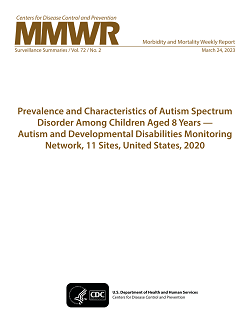Surveillance for Coccidioidomycosis — United States, 2011–2017
IF 37.3
1区 医学
Q1 PUBLIC, ENVIRONMENTAL & OCCUPATIONAL HEALTH
引用次数: 36
Abstract
Problem/Condition Coccidioidomycosis (Valley fever) is an infection caused by the environmental fungus Coccidioides spp., which typically causes respiratory illness but also can lead to disseminated disease. This fungus typically lives in soils in warm, arid regions, including the southwestern United States. Reporting Period 2011–2017. Description of System Coccidioidomycosis has been nationally notifiable since 1995 and is reportable in 26 states and the District of Columbia (DC), where laboratories and physicians notify local and state public health departments about possible coccidioidomycosis cases. Health department staff determine which cases qualify as confirmed cases according to the definition established by Council of State and Territorial Epidemiologists and voluntarily submit basic case information to CDC through the National Notifiable Diseases Surveillance System. Results During 2011–2017, a total of 95,371 coccidioidomycosis cases from 26 states and DC were reported to CDC. The number of cases decreased from 2011 (22,634 cases) to 2014 (8,232 cases) and subsequently increased to 14,364 cases in 2017; >95% of cases were reported from Arizona and California. Reported incidence in Arizona decreased from 261 per 100,000 persons in 2011 to 101 in 2017, whereas California incidence increased from 15.7 to 18.2, and other state incidence rates stayed relatively constant. Patient demographic characteristics were largely consistent with previous years, with an overall predominance among males and among adults aged >60 years in Arizona and adults aged 40–59 years in California. Interpretation Coccidioidomycosis remains an important national public health problem with a well-established geographic focus. The reasons for the changing trends in reported cases are unclear but might include environmental factors (e.g., temperature and precipitation), surveillance artifacts, land use changes, and changes in the population at risk for the infection. Public Health Action Health care providers should consider a diagnosis of coccidioidomycosis in patients who live or work in or have traveled to areas with known geographic risk for Coccidioides and be aware that those areas might be broader than previously recognized. Coccidioidomycosis surveillance provides important information about the epidemiology of the disease but is incomplete both in terms of geographic coverage and data availability. Expanding surveillance to additional states could help identify emerging areas that pose a risk for locally acquired infections. In Arizona and California, where most cases occur, collecting systematic enhanced data, such as more detailed patient characteristics and disease severity, could help clarify the reasons behind the recent changes in incidence and identify additional opportunities for focused prevention and educational efforts.球虫真菌病监测-美国,2011-2017
球虫病(谷热)是一种由环境真菌球虫引起的感染,通常会引起呼吸系统疾病,但也会导致播散性疾病。这种真菌通常生活在温暖干旱地区的土壤中,包括美国西南部。报告期2011-2017。自1995年以来,球孢子菌病已在全国范围内报告,并在26个州和哥伦比亚特区(DC)报告,实验室和医生向当地和州公共卫生部门通报可能的球孢子菌病病例。卫生部门工作人员根据州和地区流行病学家委员会制定的定义确定哪些病例符合确诊病例,并通过国家法定疾病监测系统自愿向疾病预防控制中心提交病例基本信息。结果2011-2017年,美国26个州和DC共向CDC报告球孢子菌病95,371例。从2011年(22634例)减少到2014年(8232例),2017年增加到14364例;>95%的病例报告来自亚利桑那州和加利福尼亚州。亚利桑那州报告的发病率从2011年的每10万人261人下降到2017年的101人,而加利福尼亚州的发病率从15.7人上升到18.2人,其他州的发病率保持相对稳定。患者人口学特征与前几年基本一致,总体上以男性和亚利桑那州60岁以上的成年人以及加利福尼亚州40-59岁的成年人为主。球孢子菌病仍然是一个重要的国家公共卫生问题,具有明确的地理焦点。报告病例变化趋势的原因尚不清楚,但可能包括环境因素(如温度和降水)、监测伪影、土地利用变化以及感染风险人群的变化。公共卫生行动卫生保健提供者应考虑在已知球虫地理风险地区生活或工作或旅行的患者诊断球虫菌病,并意识到这些地区可能比以前认识到的更广泛。球孢子菌病监测提供了有关该疾病流行病学的重要信息,但在地理覆盖和数据可得性方面都不完整。将监测范围扩大到更多的州,可以帮助确定对本地获得性感染构成风险的新兴地区。在大多数病例发生的亚利桑那州和加利福尼亚州,收集系统的增强数据,例如更详细的患者特征和疾病严重程度,可以帮助澄清最近发病率变化背后的原因,并确定重点预防和教育工作的额外机会。
本文章由计算机程序翻译,如有差异,请以英文原文为准。
求助全文
约1分钟内获得全文
求助全文
来源期刊

Mmwr Surveillance Summaries
PUBLIC, ENVIRONMENTAL & OCCUPATIONAL HEALTH-
CiteScore
60.50
自引率
1.20%
发文量
9
期刊介绍:
The Morbidity and Mortality Weekly Report (MMWR) Series, produced by the Centers for Disease Control and Prevention (CDC), is commonly referred to as "the voice of CDC." Serving as the primary outlet for timely, reliable, authoritative, accurate, objective, and practical public health information and recommendations, the MMWR is a crucial publication. Its readership primarily includes physicians, nurses, public health practitioners, epidemiologists, scientists, researchers, educators, and laboratorians.
 求助内容:
求助内容: 应助结果提醒方式:
应助结果提醒方式:


